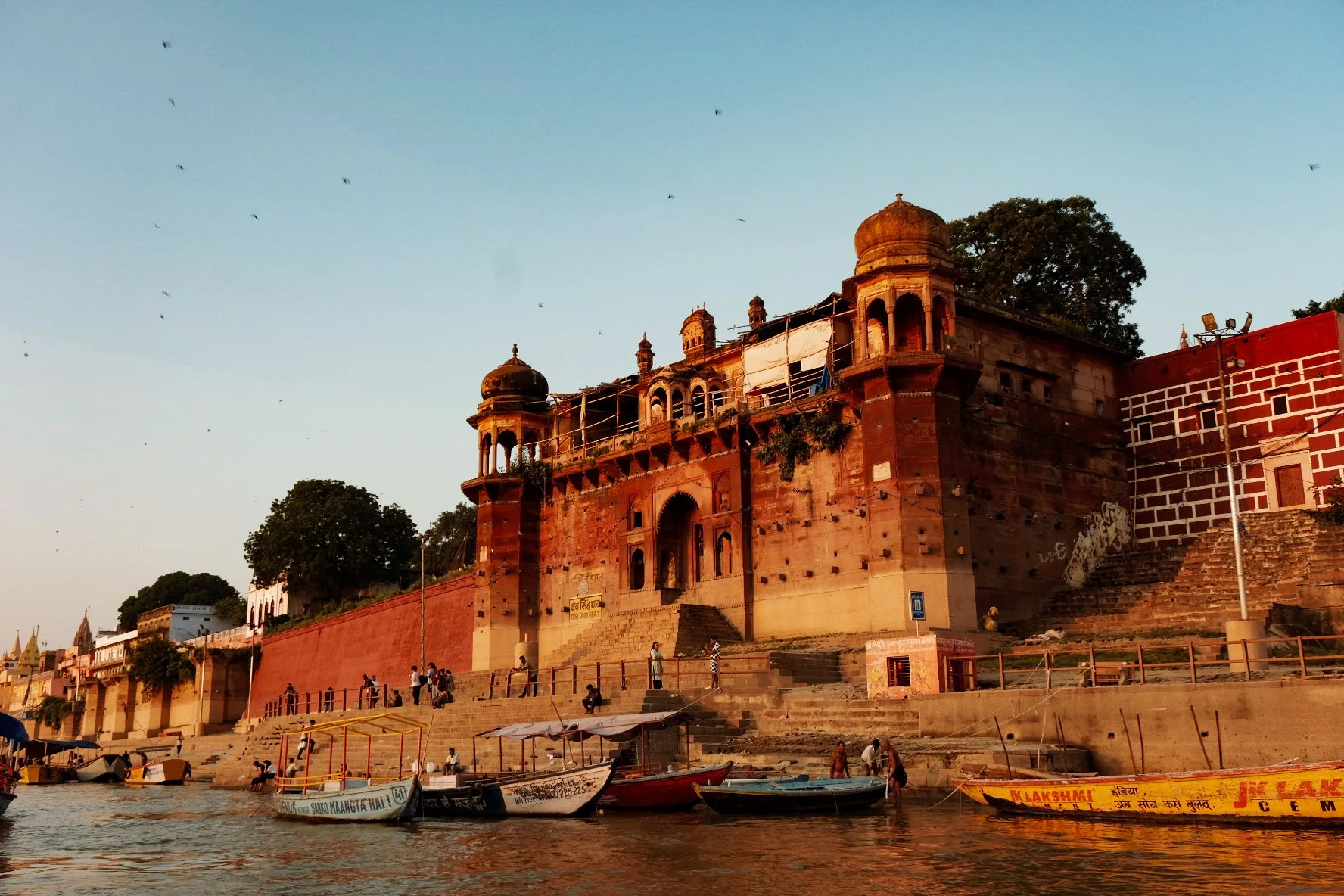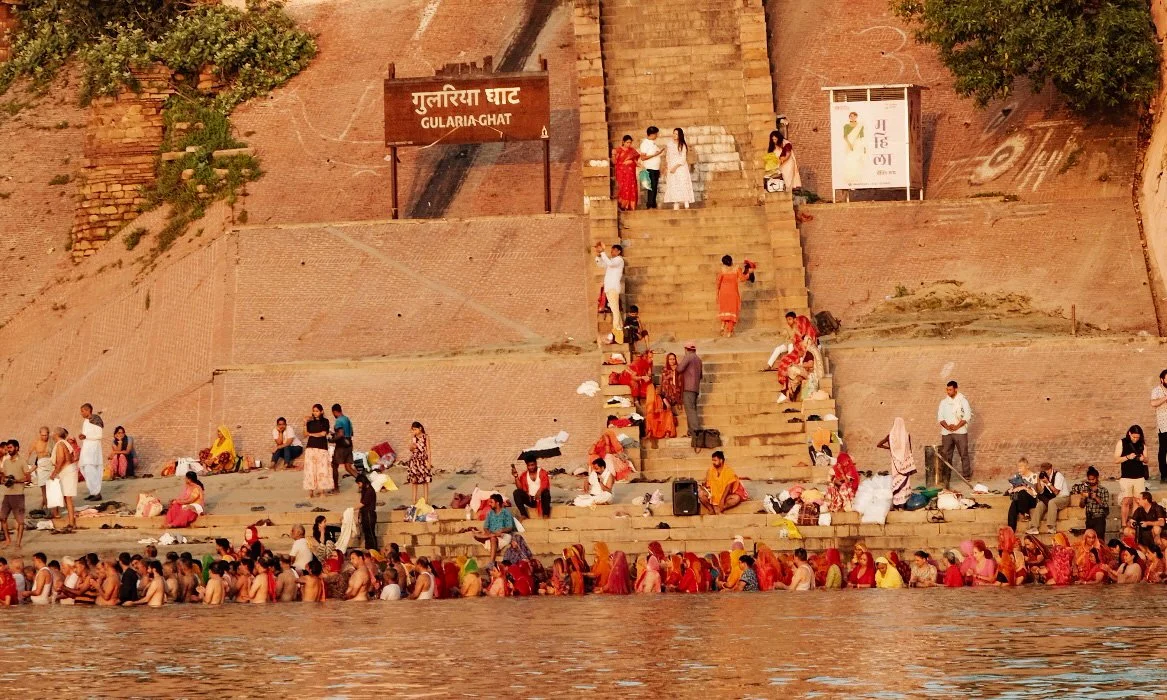It was a short trip, but one that will live forever in my mind and heart. Varanasi is probably the most spiritual place I’ve ever been—an ancient city that hums with devotion and the quiet acceptance of life and death intertwined.
Ryan and I traveled there in October 2023, and though we were only in India’s holiest city for two nights, it felt like time slowed down. We flew from Delhi to Varanasi, where our arrival was as cinematic as it gets: a boat gliding along the Ganges toward the majestic BrijRama Palace, our home for the next two nights. There is truly nothing like waking up to the Ganges—morning light filtering through the mist, bells ringing from the ghats, and the air alive with prayer.
At some point, I’ll find the words to explain it—but for now, know that Varanasi needs to be felt at dawn and again at sunset.
““The pilgrims on the mighty Ganges—celebrating life and death, twenty‑four hours a day—are a miracle in themselves.””
The Reading of the Stars
Our introduction to Varanasi began not on the river but in the cosmos. Shortly after arriving, we met with a renowned astrologer for a personal reading. I usually take such things with a grain of salt, but Ryan was completely captivated when the astrologer revealed something he had never told anyone before. As for me, I was given a foretelling—something deeply connected to an idea I’ve been quietly ideating. Whether coincidence or cosmic alignment, the moment felt charged, setting the tone for everything that followed.
The Evening Aarti
That first night, we set sail for the Ganga Aarti Ceremony, an unforgettable ritual of light, sound, and devotion. As the sun dipped below the horizon, priests along the ghats began their synchronized blessings to the sacred river—flames swirling in brass lamps, bells clanging, chants rising in waves. The lamps reflected across the water, and I remember glancing at Ryan—his face illuminated by candlelight, his skepticism giving way to wonder.
We walked along the riverbanks afterward, witnessing life, prayer, and cremation unfolding before us. Varanasi is the holiest place for Hindus, and being among the faithful—so many people honoring both the living and the departed—felt like being part of something much larger than ourselves. The pilgrims on the mighty River Ganges, celebrating life and death twenty-four hours a day, are a miracle in themselves.
Morning on the Ganges
Our second day began before sunrise. We boarded a small rowboat just as the city was stirring awake. Pilgrims young and old made their way down to the river to bathe, pray, and offer small flickering diyas (lamps) to the Ganges. As we drifted quietly past, a flute player’s melody floated across the water—haunting and beautiful. It’s impossible to describe the feeling—it was both humbling and transcendent, as if we were witnessing life in its purest form.
““At dawn on the Ganges, I finally understood why pilgrims return here for a lifetime.””
Sarnath, Weavers & Food Trails
Later that morning, we drove to the UNESCO World Heritage site of Sarnath, where the Buddha gave his first sermon on the path to Nirvana. The site radiates serenity: monks from the Vajra Vidya Institute walking in silence, ancient stupas standing sentinel over centuries of faith.
From there, we returned to the living pulse of the city—Banares, known worldwide for its silk brocades. Visiting the local weavers was like stepping into a centuries-old rhythm. Gold and silver threads shimmered on the looms, each sari a tapestry of devotion and artistry. This is the number one item to purchase here.
By late afternoon, we wandered into the maze of Varanasi’s old city for a food walk—one of my favorite ways to explore any destination. I loved weaving through the narrow lanes, sampling snacks hot from the wok, and browsing small shops tucked between temples. The air was fragrant with incense and cardamom. We ended at Blue Lassi, a tiny hole-in-the-wall that’s become legendary for good reason—it was, without question, the best lassi I’ve ever had.
Where to Stay
We stayed at BrijRama Palace by @brijhotels, which has an enviable position right on the Ganges. Built in the 18th century, it offers direct river access—meaning you’re in the thick of it from the moment you step outside. From sunrise prayers to the glow of the evening Aarti, it’s the perfect front-row seat to life on the Ganges.
Reflections
Varanasi is not a place you simply visit—it’s a place that absorbs you. From the astrologer’s insight to the dawn boat ride, every moment felt like a lesson in impermanence and faith. The rituals, the people, the quiet dignity of it all—it reminded me that in Varanasi, life and death coexist not as opposites but as part of the same sacred rhythm.
Ryan and I left with more than memories; we left with a deeper understanding of why this city has drawn pilgrims for over 3,000 years. I can still close my eyes and see the lamps floating down the river, hear the flute, and feel that sense of peace that only Varanasi can give.
Whenever I talk of India, I always go back to Varanasi. Travel to India sooner rather than later. It’s one country made up of many worlds—and at dawn on the Ganges, you’ll understand why.








































